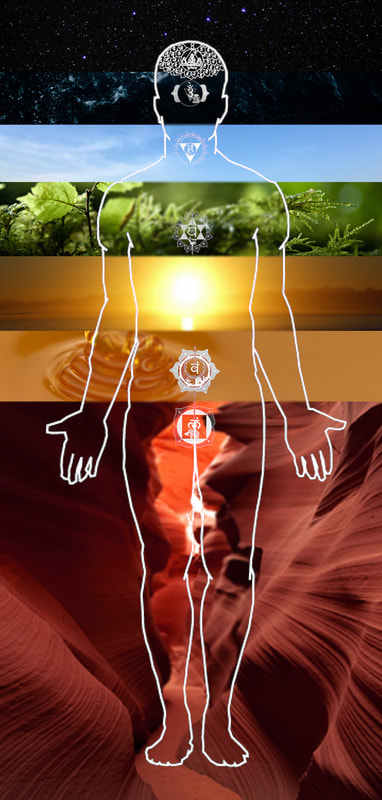 Chakra is the Sanskrit word for “wheel.” In the yoga tradition, it refers to energy centers throughout the body, most frequently to the seven major chakras aligned along sushumna nadi, the central channel for energy or prana that runs along the length of the spine. As I often remind people when I teach yoga, yoga is an ancient tradition of philosophy and practice with its roots in India and other parts of South Asia. It is a practice oriented toward liberation from suffering through the recognition of union. The chakras are part of the energetic, subtle body as mapped primarily by the Tantric tradition of yoga, and working with them is one pathway toward finding balance and harmony within yourself and in relation to the world from which you are not ultimately separate. There are many ways to work energetically with the chakras—through meditation, pranayama (breathing practices), asana (physical postures), energetic healing modalities like reiki, plant and stone healing, and cultivating behavioral practices that support the balanced opening of each energy center. One of my favorite ways to work with the chakras is through meditation, directing my attention through each one and cycling breath and awareness between them. Over the course of working with the chakras for many years, I’ve realized that I strongly associate each one with particular qualities, specific sensory experiences and feelings states that allow me to expand my awareness of each energy center. With muladhara, the root chakra that corresponds to safety, security, and our connection to our most basic needs, I associate red dirt and stone, the ancient richness of the earth. With swadisthana, the sacral chakra that corresponds to creativity, desire, pleasure, sexuality, and feeling, I associate sweetness, like the golden glow of honey that comes from the life-giving union of bees and flowers. With manipura, the solar plexus chakra that corresponds to courage, confidence, willpower, health, and vitality, I associate the blazing light of the rising sun. With anahata, the heart chakra that corresponds to love, empathy, compassion, and connection, I associate the verdant green foliage of a cool forest, tender leaves opening to receive light. With vishuddha, the throat chakra that corresponds to the voice, speech, communication, and truthfulness, I associate the vast open expanse of a clear blue sky. Imagine if your voice felt that open and free. With ajña, the third eye chakra that corresponds to intuition, inner wisdom, perception, and understanding, I associate the depths of dark waters, diving into all that is held beneath their surface. With sahasrara, the crown chakra that corresponds to the realization of our union with all things, the culminating liberation of recognizing that we are not separate, I associate the shimmering lights of stars in the infinite blackness of space. As I meditate, I invite each of these qualities and associations into the space of each chakra, and in doing so, become more aware of the sensations available to me throughout my subtle body. Try it. See what you feel. I would love to hear about your experience. If you’re looking for more information about chakras—because not everything we read on the internet is the best information—I highly recommend Anodea Judith’s book Wheels of Life: A User’s Guide to the Chakra System. You can read more about my background with yoga here. And if you are looking for support in connecting to your own subtle body and its felt wisdom, you can book a session with me here.
0 Comments
Your comment will be posted after it is approved.
Leave a Reply. |
AuthorMichael J. Morris is a witch, an astrologer, a tarot reader, an artist, a writer, and a teacher. Categories
All
Archives
April 2024
|
- Home
- About
- Bookings
- Offerings
- Events
- Tutoring and Mentorship
-
Downloads
- Transits and Transgender Liberation
- Feminist Astrology and the Moon
- Feminist Astrology: Mars, Violence, and War
- Celestial Kinship
- Introduction to Ritual Workshop + Beltane Ritual
- Minor Asteroids in the Birth Chart and Ritual
- Astrology Guide for 2022
- The Atomic Age, Urgency, Danger, and Kinship: Astrology and Climate Collapse
- Asteroids in Astrology: Nuance, Subtlety, and Direction
- Tarot Workshop with Michael J. Morris
- Astrology as an Artistic Practice: As It Is Made, So It Makes
- Astrology Guide for 2021
- Celestial Corporeality: Astrology and the Body
- Astrology Consultations as Feminist Praxis
- Embodying Astrological Archetypes
- Resources
- Blog
- Testimonials
- Policies
- Gratitude
Copyright © 2020

 RSS Feed
RSS Feed